maintenance schedule CADILLAC ESCALADE ESV 2008 User Guide
[x] Cancel search | Manufacturer: CADILLAC, Model Year: 2008, Model line: ESCALADE ESV, Model: CADILLAC ESCALADE ESV 2008Pages: 500, PDF Size: 6.65 MB
Page 377 of 500
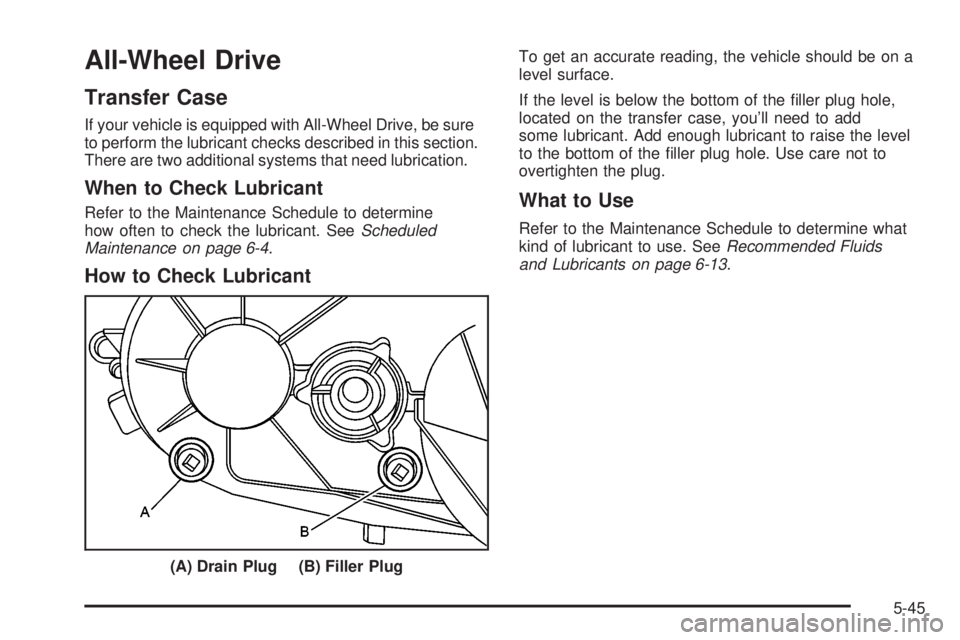
All-Wheel Drive Transfer Case If your vehicle is equipped with All-Wheel Drive, be sure
to perform the lubricant checks described in this section.
There are two additional systems that need lubrication.
When to Check Lubricant Refer to the Maintenance Schedule to determine
how often to check the lubricant. See Scheduled
Maintenance on page 6-4 .
How to Check Lubricant To get an accurate reading, the vehicle should be on a
level surface.
If the level is below the bottom of the �ller plug hole,
located on the transfer case, you’ll need to add
some lubricant. Add enough lubricant to raise the level
to the bottom of the �ller plug hole. Use care not to
overtighten the plug.
What to Use Refer to the Maintenance Schedule to determine what
kind of lubricant to use. See Recommended Fluids
and Lubricants on page 6-13 .
(A) Drain Plug (B) Filler Plug
5-45
Page 379 of 500
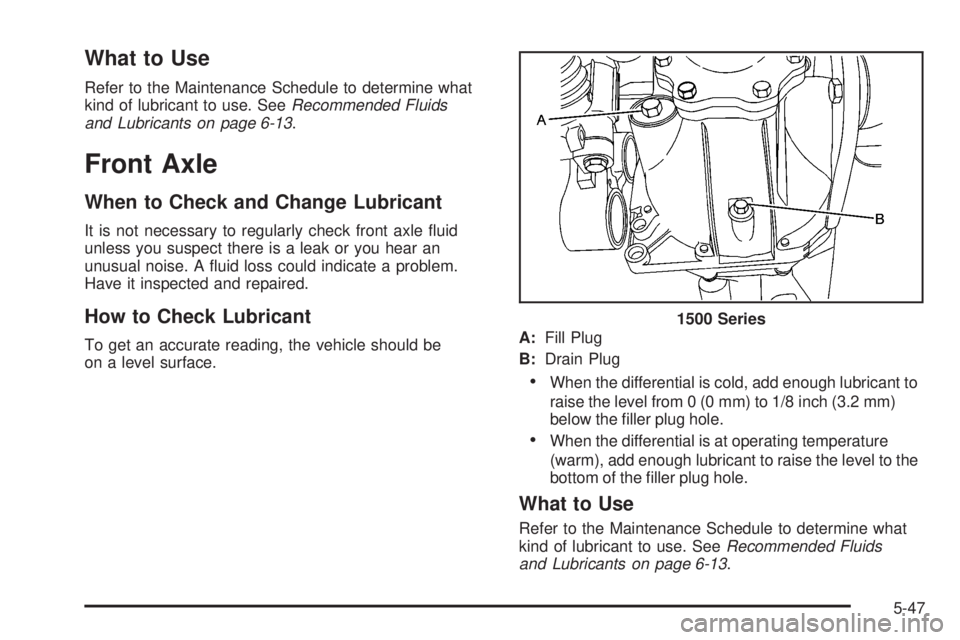
What to Use Refer to the Maintenance Schedule to determine what
kind of lubricant to use. See Recommended Fluids
and Lubricants on page 6-13 .
Front Axle When to Check and Change Lubricant It is not necessary to regularly check front axle �uid
unless you suspect there is a leak or you hear an
unusual noise. A �uid loss could indicate a problem.
Have it inspected and repaired.
How to Check Lubricant To get an accurate reading, the vehicle should be
on a level surface. A: Fill Plug
B: Drain Plug
When the differential is cold, add enough lubricant to
raise the level from 0 (0 mm) to 1/8 inch (3.2 mm)
below the �ller plug hole.
When the differential is at operating temperature
(warm), add enough lubricant to raise the level to the
bottom of the �ller plug hole.
What to Use Refer to the Maintenance Schedule to determine what
kind of lubricant to use. See Recommended Fluids
and Lubricants on page 6-13 .1500 Series
5-47
Page 386 of 500

Windshield Wiper Blade
Replacement Windshield wiper blades should be inspected for wear
or cracking. See Scheduled Maintenance on page 6-4 .
Replacement blades come in different types and
are removed in different ways. To replace the wiper
blade assembly:
1. Pull the windshield wiper arm connector away from
the windshield.
2. Squeeze the grooved areas on each side of the
blade, and turn the blade assembly away from
the arm connector. 3. Install the new blade onto the arm connector and
make sure the grooved areas are fully set in the
locked position.
For the proper type and size, see Maintenance
Replacement Parts on page 6-15 .
5-54
Page 401 of 500
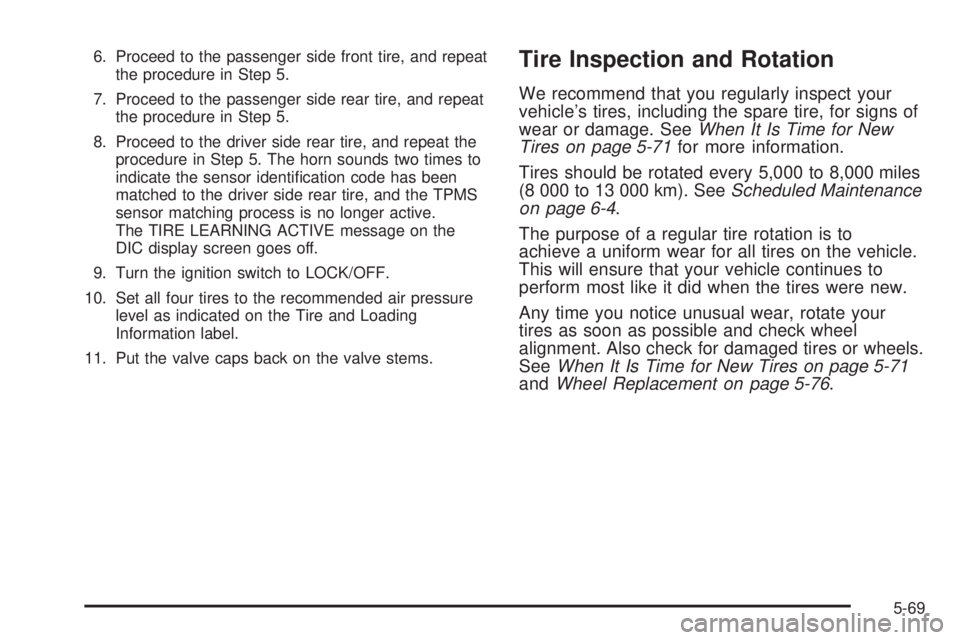
6. Proceed to the passenger side front tire, and repeat
the procedure in Step 5.
7. Proceed to the passenger side rear tire, and repeat
the procedure in Step 5.
8. Proceed to the driver side rear tire, and repeat the
procedure in Step 5. The horn sounds two times to
indicate the sensor identi�cation code has been
matched to the driver side rear tire, and the TPMS
sensor matching process is no longer active.
The TIRE LEARNING ACTIVE message on the
DIC display screen goes off.
9. Turn the ignition switch to LOCK/OFF.
10. Set all four tires to the recommended air pressure
level as indicated on the Tire and Loading
Information label.
11. Put the valve caps back on the valve stems. Tire Inspection and Rotation We recommend that you regularly inspect your
vehicle’s tires, including the spare tire, for signs of
wear or damage. See When It Is Time for New
Tires on page 5-71 for more information.
Tires should be rotated every 5,000 to 8,000 miles
(8 000 to 13 000 km). See Scheduled Maintenance
on page 6-4 .
The purpose of a regular tire rotation is to
achieve a uniform wear for all tires on the vehicle.
This will ensure that your vehicle continues to
perform most like it did when the tires were new.
Any time you notice unusual wear, rotate your
tires as soon as possible and check wheel
alignment. Also check for damaged tires or wheels.
See When It Is Time for New Tires on page 5-71
and Wheel Replacement on page 5-76 .
5-69
Page 449 of 500
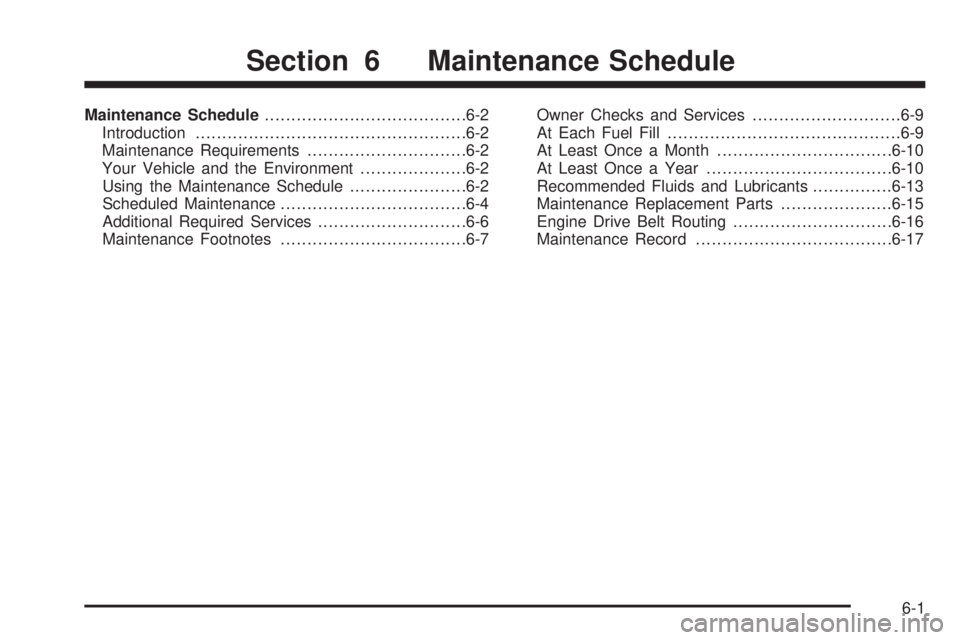
Maintenance Schedule ..................................... .6-2
Introduction .................................................. .6-2
Maintenance Requirements ............................. .6-2
Your Vehicle and the Environment ................... .6-2
Using the Maintenance Schedule ..................... .6-2
Scheduled Maintenance .................................. .6-4
Additional Required Services ........................... .6-6
Maintenance Footnotes .................................. .6-7 Owner Checks and Services ........................... .6-9
At Each Fuel Fill ........................................... .6-9
At Least Once a Month ................................ .6-10
At Least Once a Year .................................. .6-10
Recommended Fluids and Lubricants .............. .6-13
Maintenance Replacement Parts .................... .6-15
Engine Drive Belt Routing ............................. .6-16
Maintenance Record .................................... .6-17
Section 6 Maintenance Schedule
6-1
Page 450 of 500
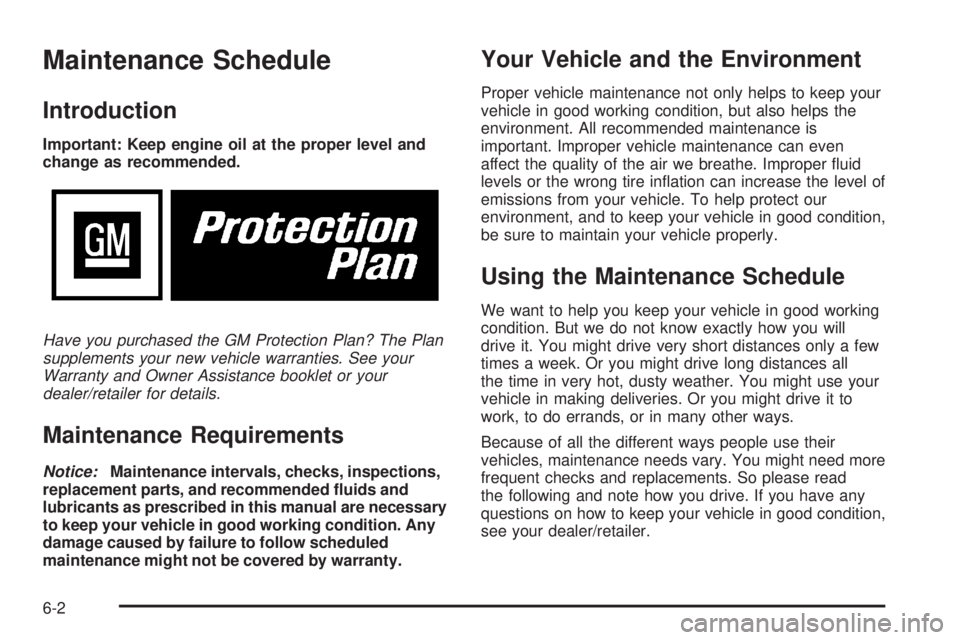
Maintenance Schedule Introduction Important: Keep engine oil at the proper level and
change as recommended.
Have you purchased the GM Protection Plan? The Plan
supplements your new vehicle warranties. See your
Warranty and Owner Assistance booklet or your
dealer/retailer for details.
Maintenance Requirements Notice: Maintenance intervals, checks, inspections,
replacement parts, and recommended �uids and
lubricants as prescribed in this manual are necessary
to keep your vehicle in good working condition. Any
damage caused by failure to follow scheduled
maintenance might not be covered by warranty. Your Vehicle and the Environment Proper vehicle maintenance not only helps to keep your
vehicle in good working condition, but also helps the
environment. All recommended maintenance is
important. Improper vehicle maintenance can even
affect the quality of the air we breathe. Improper �uid
levels or the wrong tire in�ation can increase the level of
emissions from your vehicle. To help protect our
environment, and to keep your vehicle in good condition,
be sure to maintain your vehicle properly.
Using the Maintenance Schedule We want to help you keep your vehicle in good working
condition. But we do not know exactly how you will
drive it. You might drive very short distances only a few
times a week. Or you might drive long distances all
the time in very hot, dusty weather. You might use your
vehicle in making deliveries. Or you might drive it to
work, to do errands, or in many other ways.
Because of all the different ways people use their
vehicles, maintenance needs vary. You might need more
frequent checks and replacements. So please read
the following and note how you drive. If you have any
questions on how to keep your vehicle in good condition,
see your dealer/retailer.
6-2
Page 451 of 500
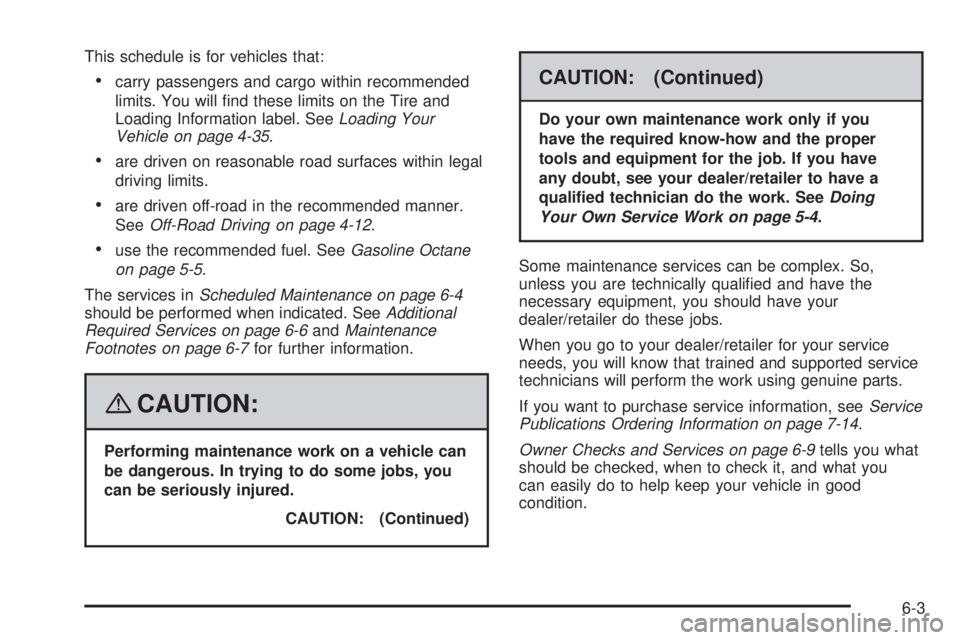
This schedule is for vehicles that:
carry passengers and cargo within recommended
limits. You will �nd these limits on the Tire and
Loading Information label. See Loading Your
Vehicle on page 4-35 .
are driven on reasonable road surfaces within legal
driving limits.
are driven off-road in the recommended manner.
See Off-Road Driving on page 4-12 .
use the recommended fuel. See Gasoline Octane
on page 5-5 .
The services in Scheduled Maintenance on page 6-4
should be performed when indicated. See Additional
Required Services on page 6-6 and Maintenance
Footnotes on page 6-7 for further information.
{ CAUTION: Performing maintenance work on a vehicle can
be dangerous. In trying to do some jobs, you
can be seriously injured.
CAUTION: (Continued) CAUTION: (Continued) Do your own maintenance work only if you
have the required know-how and the proper
tools and equipment for the job. If you have
any doubt, see your dealer/retailer to have a
quali�ed technician do the work. See Doing
Your Own Service Work on page 5-4 .
Some maintenance services can be complex. So,
unless you are technically quali�ed and have the
necessary equipment, you should have your
dealer/retailer do these jobs.
When you go to your dealer/retailer for your service
needs, you will know that trained and supported service
technicians will perform the work using genuine parts.
If you want to purchase service information, see Service
Publications Ordering Information on page 7-14 .
Owner Checks and Services on page 6-9 tells you what
should be checked, when to check it, and what you
can easily do to help keep your vehicle in good
condition.
6-3
Page 452 of 500

The proper replacement parts, �uids, and lubricants to
use are listed in Recommended Fluids and Lubricants
on page 6-13 and Maintenance Replacement Parts
on page 6-15 . When your vehicle is serviced, make sure
these are used. All parts should be replaced and all
necessary repairs done before you or anyone else
drives the vehicle. We recommend the use of genuine
parts from your dealer/retailer.
Scheduled Maintenance To maintain the ride, handling, and performance of your
vehicle, it is important that the �rst tire rotation service
be performed when the vehicle has 5,000 to 8,000 miles
(8 000 to 13 000 km). Check tires for in�ation pressures
and wear. See Tires on page 5-56 . Rotate tires. See
Tire Inspection and Rotation on page 5-69 and
“Tire Wear Inspection” in At Least Once a Month on
page 6-10 . When the CHANGE ENGINE OIL SOON message
comes on, it means that service is required for your
vehicle. Have your vehicle serviced as soon as possible
within the next 600 miles (1 000 km). It is possible
that, if you are driving under the best conditions, the
engine oil life system may not indicate that vehicle
service is necessary for over a year. However,
the engine oil and �lter must be changed at least once
a year and at this time the system must be reset.
Your dealer/retailer has trained service technicians who
will perform this work using genuine parts and reset
the system.
If the engine oil life system is ever reset accidentally,
you must service your vehicle within 3,000 miles
(5 000 km) since your last service. Remember to reset
the oil life system whenever the oil is changed. See
Engine Oil Life System on page 5-16 for information on
the Engine Oil Life System and resetting the system.
6-4
Page 465 of 500

Maintenance Record After the scheduled services are performed, record the date, odometer reading, who performed the service, and the
type of services performed in the boxes provided. See Maintenance Requirements on page 6-2 . Any additional
information from Owner Checks and Services on page 6-9 can be added on the following record pages. You should
retain all maintenance receipts.
Maintenance RecordDate Odometer
Reading Serviced By Maintenance Stamp Services Performed
6-17
Page 472 of 500
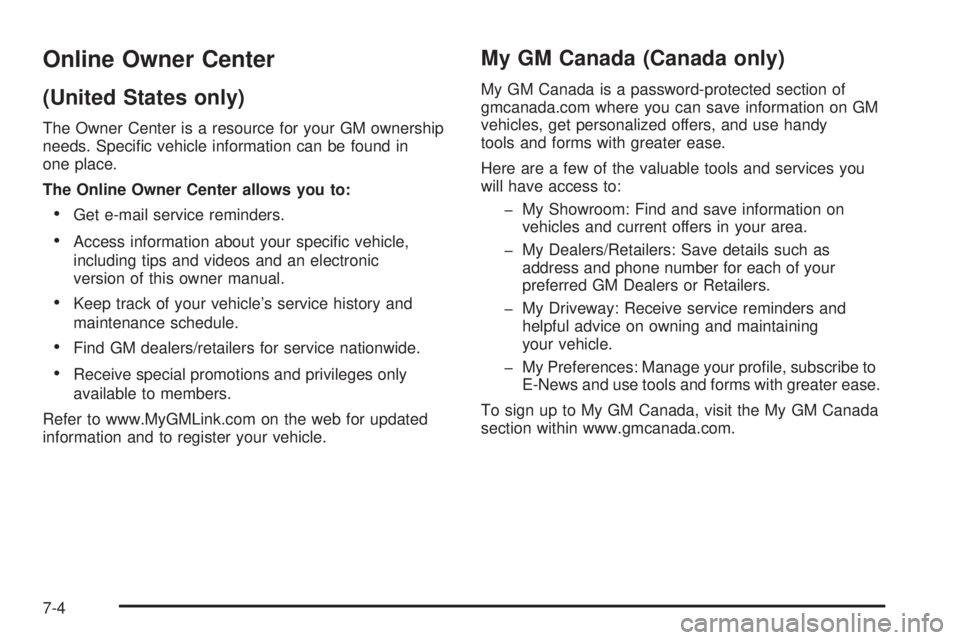
Online Owner Center (United States only) The Owner Center is a resource for your GM ownership
needs. Speci�c vehicle information can be found in
one place.
The Online Owner Center allows you to:
Get e-mail service reminders.
Access information about your speci�c vehicle,
including tips and videos and an electronic
version of this owner manual.
Keep track of your vehicle’s service history and
maintenance schedule.
Find GM dealers/retailers for service nationwide.
Receive special promotions and privileges only
available to members.
Refer to www.MyGMLink.com on the web for updated
information and to register your vehicle. My GM Canada (Canada only) My GM Canada is a password-protected section of
gmcanada.com where you can save information on GM
vehicles, get personalized offers, and use handy
tools and forms with greater ease.
Here are a few of the valuable tools and services you
will have access to:
� My Showroom: Find and save information on
vehicles and current offers in your area.
� My Dealers/Retailers: Save details such as
address and phone number for each of your
preferred GM Dealers or Retailers.
� My Driveway: Receive service reminders and
helpful advice on owning and maintaining
your vehicle.
� My Preferences: Manage your pro�le, subscribe to
E-News and use tools and forms with greater ease.
To sign up to My GM Canada, visit the My GM Canada
section within www.gmcanada.com.
7-4